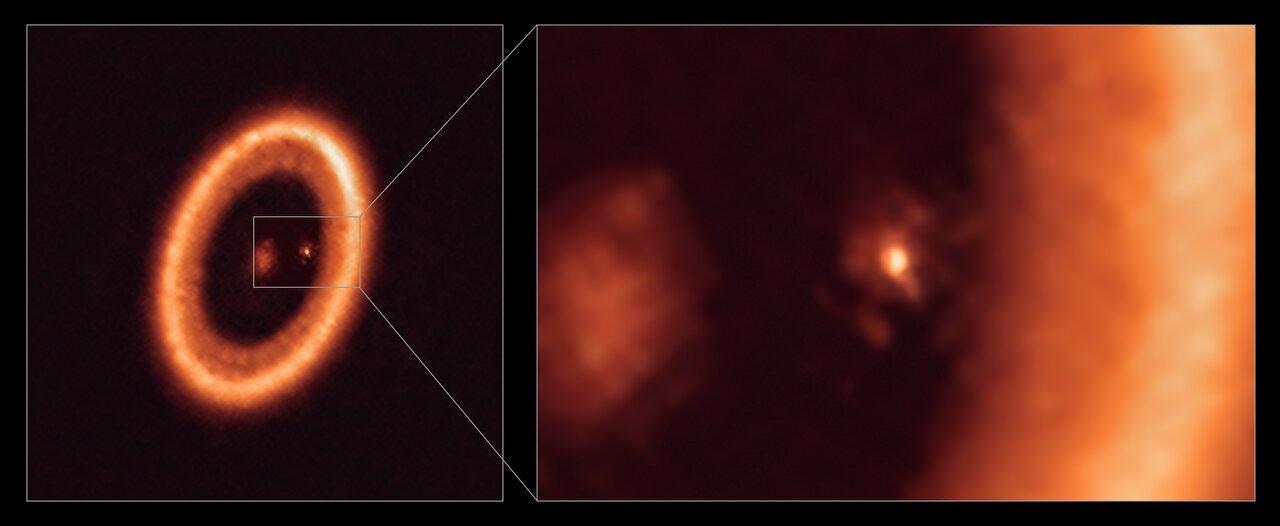For the first time, astronomers have detected the existence of a disk around a planet, present outside the solar system, with the help of the Atacama Large Millimeter/submillimeter Array (ALMA).
 Wide and close-up views of a moon-forming disc as seen with ALMA. Image Credit: ALMA (ESO/NAOJ/NRAO)/Benisty et al.
Wide and close-up views of a moon-forming disc as seen with ALMA. Image Credit: ALMA (ESO/NAOJ/NRAO)/Benisty et al.
This was achieved in collaboration with European Southern Observatory (ESO). The observation will offer new insights into how planets and moons are formed in young stellar systems.
Our work presents a clear detection of a disc in which satellites could be forming. Our ALMA observations were obtained at such exquisite resolution that we could clearly identify that the disc is associated with the planet and we are able to constrain its size for the first time.
Myriam Benisty, Researcher, University of Grenoble
Myriam Benisty is also a researcher at the University of Chile. The study was published in The Astrophysical Journal Letters on July 23rd, 2021.
The disk under investigation is known as the circumplanetary disk, which envelops the exoplanet PDS 70c, one of the two giant, Jupiter-like planets orbiting a star located 400 light-years away.
Astronomers have also traced hints of a “moon-forming” disk present around this exoplanet before but so far, they could not confirm the detection as they have been not able to differentiate the disk from the surrounding environment.
Using ALMA, Benisty and her team have also discovered that the disk has the same diameter as the distance from the Sun to the Earth. It also exhibits sufficient mass to form up to three satellites similar to the size of the moon.
According to Jaehan Bae, the outcomes are not only important to identify how moons emerge.
These new observations are also extremely important to prove theories of planet formation that could not be tested until now.
Jaehan Bae, Study Author and Researcher, Earth and Planets Laboratory, Carnegie Institution for Science
Planets emerge in dusty disks near the young stars by craving out cavities as they gobble up materials from this circumstellar disk to grow. During this process, the planet can acquire its circumplanetary disk, which adds to the growth of the planet by controlling the number of materials dropping onto it.
Meanwhile, the gas and dust present in the circumplanetary disk can unite into increasingly large bodies via multiple collisions, finally resulting in the birth of moons. However, astronomers have not completely understood the particulars of these processes.
“In short, it is still unclear when, where, and how planets and moons for,” stated Stefano Facchini, Research Fellow, European Southern Observatory
More than 4000 exoplanets have been found until now, but all of them were detected in mature systems. PDS 70b and PDS 70c, which form a system reminiscent of the Jupiter-Saturn pair, are the only two exoplanets detected so far that are still in the process of being formed.
Miriam Keppler, Study Co-Author and Researcher, Astronomy, Max Planck Institute
“This system therefore offers us a unique opportunity to observe and study the processes of planet and satellite formation,” added Facchini.
The two planets that form the system PDS 70b and PDS 70c were initially discovered using the Very Large Telescope (VLT) at ESO in 2018 and 2019, respectively. Their unique nature implies that they have been noted with other telescopes and instruments several times from then.
The new high-resolution ALMA observations have currently enabled astronomers to gain additional knowledge into the system. Apart from verifying the detection of the circumplanetary disk around PDS 70c and observing its size and mass, the scientists also observed that PDS 70b does not exhibit any convincing proof of such a disk. This denotes that it was lacking dust materials from its birth environment by PDS 70c.
Further understandings of the planetary system will be obtained with ESO’s Extremely Large Telescope (ELT), which is under construction on Cerro Armazones in the Chilean Atacama desert.
“The ELT will be key for this research since, with its much higher resolution, we will be able to map the system in great detail,” stated Richard Teague, Study Co-Author, and Researcher, Center for Astrophysics Harvard & Smithsonian.
Specifically, employing the Mid-infrared Imager and Spectrograph (METIS) feature of ELT enabled the team to observe the gas motions surrounding PDS 70c to obtain a full 3D picture of the system.
Journal Reference:
Benisty, M., et al. (2021) A Circumplanetary Disk around PDS70c. The Astrophysical Journal Letters. doi.org/10.3847/2041-8213/ac0f83.